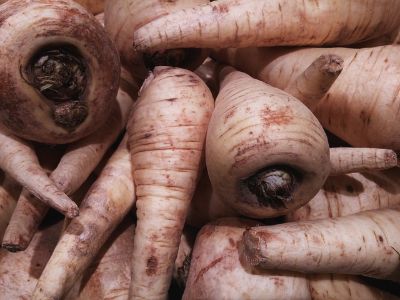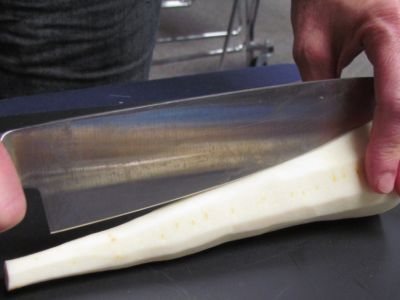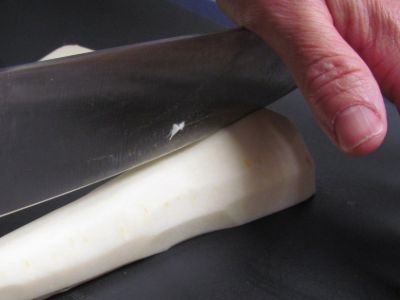Parsnips

Preparation: Step-by-Step

Wash hands. Thoroughly scrub parsnips with a brush
to remove dirt and sand on the outer layer.
If desired, peel with a vegetable peeler or knife.

Hold the parsnip to cut in half lengthwise. If roasting or
boiling, cut into 1/4- to 1/2-inch chunks.

To slice for sautéing, set the flat side down on the
cutting board and cut in half again. If the parsnip is large,
remove the woody center.

If the parsnip is long, cut in half, then slice into 1/4-inch
thick strips. Sauté in a pan with butter and seasonings.
Cooking brings out the natural sweetness of parsnips.
Grow.
- Many parts of Montana may not have a long enough growing season between frosts to
grow a decent parsnip. Plant seeds as soon as you can work the soil. Sow 1/2-inch
deep, spaced 3-4 inches apart, and in rows 18 inches apart. Water 1-2 inches per week.
Parsnips prefer cooler temperatures.
For more growing information, look for the MSU Extension MontGuide: Planting a Successful Home Vegetable Garden, or contact your local MSU Extension office.
Harvest.
- Parsnip is considered a winter vegetable because its flavor is not fully developed until the roots have been exposed to near-freezing temperatures for 2-4 weeks in the fall and early winter. The root should be well-developed after being in the ground for around four months. Many gardeners leave parsnips in the ground over the winter and harvest in the spring.
- When storing parsnips, remove leaves and refrigerate parsnips unwashed in an unsealed bag for three weeks or more. Parsnips keep best in a perforated bag in the vegetable bin of the refrigerator.
- Store in the refrigerator, wrapped in a perforated plastic bag. Perforations in the bag allow excess moisture to escape. Avoid storing grapes next to strong-smelling food, such as green onions or leeks.
- Most vegetables are rich in fiber and phytochemicals, but provide negligible amounts of saturated fat, trans fat, cholesterol, and sodium and are gluten-free. Parsnips are rich in Vitamin C, folate, potassium and magnesium and they have 55 calories per half-cup serving.
Grate.
- Use grated parsnips in place of cabbage in a favorite coleslaw recipe.
Bake.
- Place whole or cut parsnips in a baking dish with a cover. Cook 20-30 minutes in 350°F degree oven.
Boil or Steamed.
- Place trimmed, well-scrubbed parsnips in a steamer or pan of boiling water. Steam or boil about 12-15 minutes or until tender. Combine with mashed potatoes to enhance flavor and add fiber or eat mashed on their own.
Microwave.
- Cut parsnips into 1- to 1½-inch chunks and place them in a microwavable dish with two tablespoons of liquid. Cover with a lid or vented plastic wrap. Microwave on high for 4-6 minutes or until tender.
Sauté.
- Heat pan to high, add butter or oil to coat bottom of pan, then add chopped 1/2- to 1-inch pieces of parsnips. Stir parsnips for even browning. Sauté about 12-15 minutes or until tender.
Season.
- To enhance the flavor of parsnips, use ginger, mace, nutmeg and/or cinnamon.
Preserve.
- For more information on preserving vegetables, view these MSU Extension MontGuides: Freezing Vegetables and Drying Vegetables. Or contact your local MSU Extension office.
For More Information:
Montana State University Extension: msuextension.org
MSU Extension Master Gardener: mtmastergardener.org
MSU Extension Food and Nutrition: nutrition.msuextension.org
MSU Extension Nutrition Education Programs: buyeatlivebetter.org
Date of Publication: January 2014
